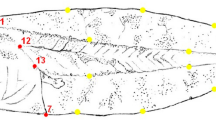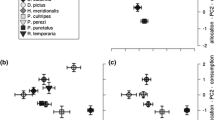Abstract
Hydroperiod length has been identified as a major driver in community assembly in freshwater systems. Yet we generally lack an understanding of how morphological traits respond to water level decrease under natural conditions. Here, we studied variation in body size and shape in lateral view in tadpoles of Scinax squalirostris and Odontophrynus americanus inhabiting ponds in superhumid highland plateau in southern Brazil. Hydroperiod did not affect tadpole size in either species. In relation to body shape, S. squalirostris tadpoles from long hydroperiod ponds had shorter tails and deeper tail fins than tadpoles from other hydroperiods. Predator presence was positively associated with hydroperiod, restricting our ability to separate their effects on tadpoles morphology. For O. americanus, tadpole shape was not affected by pond hydroperiod. We demonstrated that, in natural environment, the influence of hydroperiod on tadpole morphology might depend on species-specific characteristics, such as behavior and life-history traits. Our results indicate that local context may lead to different effects of hydroperiod, and hydroperiod alone can only partly explain the variation on tadpole shape.



Similar content being viewed by others
Data availability
The data for this study can be accessed upon request to the corresponding author.
References
Adams DC, Collyer ML, Kaliontzopoulou A (2019) Geomorph: software for geometric morphometric analyses. Evolution 73:2352–2367
Alford RA (1999) Ecology: resource use, competition, and predation. In: McDiarmid RW, Altig R (eds) Tadpoles: the biology of anuran larvae. The University of Chicago Press, Chicago, pp 240–278
Altig R, Johnston GF (1989) Guilds of anuran larvae: relationships among developmental modes, morphologies, and habitats. Herpetol Monogr 3:81–109
Altwegg R, Reyer HU (2003) Patterns of natural selection on size at metamorphosis in water frogs. Evolution 57:872–882. https://doi.org/10.1111/j.0014-3820.2003.tb00298.x
Amburgey S, Funk WC, Murphy M, Muths E (2012) Effects of hydroperiod duration on survival, developmental rate, and size at metamorphosis in Boreal Chorus Frog tadpoles (Pseudacris maculata). Herpetologica 68:456–467. https://doi.org/10.1655/HERPETOLOGICA-D-11-00093
Amburgey SM, Murphy M, Chris Funk W (2016) Phenotypic plasticity in developmental rate is insufficient to offset high tadpole mortality in rapidly drying ponds. Ecosphere 7:1–14. https://doi.org/10.1002/ecs2.1386
Auld JR, Agrawal AA, Relyea RA (2010) Re-evaluating the costs and limits of adaptive phenotypic plasticity. Proc R Soc B Biol Sci 277:503–511. https://doi.org/10.1098/rspb.2009.1355
Baber MJ, Fleishman E, Babbitt KJ, Tarr TL (2004) The relationship between wetland hydroperiod and nestedness patterns in assemblages of larval amphibians and predatory macroinvertebrates. Oikos 107:16–27
Bates D, Maechler M, Bolker B, Walker S (2015) Fitting linear mixed-effects models using lme4. J Stat Softw 67:1–48. https://doi.org/10.18637/jss.v067.i01
Benard MF (2004) Predator-induced phenotypic plasticity in organisms with complex life histories. Annu Rev Ecol Evol Syst 35:651–673. https://doi.org/10.2307/annurev.ecolsys.35.021004.30000024
Boone MD, Little EE, Semlitsch RD (2004) Overwintered Bullfrog tadpoles negatively affect Salamanders and Anurans in native amphibian communities. Copeia. https://doi.org/10.1643/CE-03-229R1
Both C, Cechin SZ, Melo AS, Hartz SM (2011) What controls tadpole richness and guild composition in ponds in subtropical grasslands? Aust Ecol 36:530–536. https://doi.org/10.1111/j.1442-9993.2010.02183.x
Brannelly LA, Ohmer MEB, Saenz V, Richards-Zawacki CL (2019) Effects of hydroperiod on growth, development, survival and immune defences in a temperate amphibian. Funct Ecol 33:1952–1961. https://doi.org/10.1111/1365-2435.13419
Cordeiro-Estrela P, Baylac M, Denys C, Marinho-Filho J (2006) Interspecific patterns of skull variation between sympatric Brazilian vesper mice: geometric morphometrics assessment. J Mammal 87:1270–1279. https://doi.org/10.1644/05-mamm-a-293r3.1
de Almeida AP, Rodrigues DJ, Garey MV, Menin M (2015) Tadpole richness in riparian areas is determined by niche-based and neutral processes. Hydrobiologia 745:123–135. https://doi.org/10.1007/s10750-014-2099-7
Eterovick PC, Sazima I (2004) Amphibians from the Serra do Cipo. PUC Minas, Belo Horizonte
Eterovick PC, Kloh JS, Figueredo CC et al (2020) Background choice and immobility as context dependent tadpole responses to perceived predation risk. Sci Rep 10:1–9. https://doi.org/10.1038/s41598-020-70274-w
Ferrari MCO, Manek AK, Chivers DP (2010) Temporal learning of predation risk by embryonic amphibians. Biol Lett 6:308–310. https://doi.org/10.1098/rsbl.2009.0798
Garland T (2014) Trade-offs. Curr Biol 24:60–61. https://doi.org/10.1016/j.cub.2013.11.036
Gilman SE, Urban MC, Tewksbury J et al (2010) A framework for community interactions under climate change. Trends Ecol Evol 25:325–331. https://doi.org/10.1016/j.tree.2010.03.002
Grözinger F, Thein J, Feldhaar H, Rödel MO (2014) Giants, dwarfs and the environment: metamorphic trait plasticity in the common frog. PLoS ONE. https://doi.org/10.1371/journal.pone.0089982
Johansson F, Lederer B, Lind MI (2010) Trait performance correlations across life stages under environmental stress conditions in the common frog, Rana temporaria. PLoS One. https://doi.org/10.1371/journal.pone.0011680
Johnson JB, Burt DB, DeWitt TJ (2008) Form, function, and fitness: pathways to survival. Evolution 62:1243–1251. https://doi.org/10.1111/j.1558-5646.2008.00343.x
Johnson JB, Saenz D, Adams CK, Hibbitts TJ (2015) Naturally occurring variation in tadpole morphology and performance linked to predator regime. Ecol Evol 5:2991–3002. https://doi.org/10.1002/ece3.1538
Knauth DS, Moreira LFB, Maltchik L (2018) Partitioning tadpole beta diversity in highland ponds with different hydroperiods. Freshw Sci. https://doi.org/10.1086/697926
Maluf JRT (2000) Nova classificação climática do Estado do Rio Grande do Sul. Rev Bras Agrometeorol 8:141–150
Maneyro R, Carreira S (2012) Guía de anfíbios del Urugay. Ediciones de la Fuga, Montevideo
Marques NS, Nomura F (2015) Where to live? How morphology and evolutionary history predict microhabitat choice by tropical tadpoles. Biotropica 47:227–235. https://doi.org/10.1111/btp.12199
Melo LSO, Garey MV, Rossa-Feres DC (2018) Looking for a place: how are tadpoles distributed within tropical ponds and streams? Herpetol Notes 11:379–386
Menge BA, Olson AM (1990) Role of scale and environmental factors in regulation of community structure. Trends Ecol Evol 5:52–57. https://doi.org/10.1016/0169-5347(90)90048-I
Merilä J, Laurila A, Pahkala M, Räsänen K, Timenes LA (2000) Adaptive phenotypic plasticity in timing of metamorphosis in the common frog Rana temporaria. Ecoscience 7:18–24. https://doi.org/10.1080/11956860.2000.11682566
Michel MJ (2011) Spatial dependence of phenotype-environment associations for tadpoles in natural ponds. Evol Ecol 25:915–932. https://doi.org/10.1007/s10682-010-9441-y
Miner BG, Sultan SE, Morgan SG et al (2005) Ecological consequences of phenotypic plasticity. Trends Ecol Evol 20:685–692. https://doi.org/10.1016/j.tree.2005.08.002
Mitchell MD, Chivers DP, Brown GE, Ferrari MCO (2016) Living on the edge: How does environmental risk affect the behavioural and cognitive ecology of prey? Anim Behav 115:185–192. https://doi.org/10.1016/j.anbehav.2016.03.018
Moreira LFB, Machado IF, Garcia TV, Maltchik L (2010) Factors influencing anuran distribution in coastal dune wetlands in southern Brazil. J Nat Hist 44:1493–1507. https://doi.org/10.1080/00222931003632690
Moreira LFB, Dorado-Rodrigues TF, Ferreira VL, Strüssmann C (2017) An inter-dependence of flood and drought: disentangling amphibian beta diversity in seasonal floodplains. Mar Freshw Res 68:2115–2122. https://doi.org/10.1071/MF16391
Morey S, Reznick D (2000) A comparative analysis of plasticity in larval development in three species of spadefoot toads. Ecology 81:1736–1749. https://doi.org/10.1890/0012-9658(2000)081[1736:ACAOPI]2.0.CO;2
Navarro-Lozano A, Sánchez-Domene D, Rossa-Feres DC et al (2018) Are oral deformities in tadpoles accurate indicators of anuran chytridiomycosis? PLoS ONE 13:1–9. https://doi.org/10.1371/journal.pone.0190955
Nomura F, do Prado VHM, da Silva FR et al (2011) Are you experienced? Predator type and predator experience trade-offs in relation to tadpole mortality rates. J Zool 284:144–150. https://doi.org/10.1111/j.1469-7998.2011.00791.x
Nylin S, Gotthard K (1998) Plasticity in life-history traits. Annu Rev Entomol 43:63–83. https://doi.org/10.1146/annurev.ento.43.1.63
Ocock JF, Kingsford RT, Penman TD, Rowley JJL (2014) Frogs during the flood: differential behaviours of two amphibian species in a dryland floodplain wetland. Aust Ecol 39:929–940. https://doi.org/10.1111/aec.12158
Purrenhage JL, Boone MD (2009) Amphibian community response to variation in habitat structure and competitor density. Herpetologica 65:14–30. https://doi.org/10.1655/08-017R1.1
Ramalho WP, Machado IF, Vieira LJS (2018) Do flood pulses structure amphibian communities in floodplain environments? Biotropica 50:338–345. https://doi.org/10.1111/btp.12523
Relyea RA (2004) Fine-tuned phenotypes: tadpole plasticity under 16 combinations of predators and competitors. Ecology 85:172–179. https://doi.org/10.1890/03-0169
Relyea RA (2007) Getting out alive: How predators affect the decision to metamorphose. Oecologia 152:389–400. https://doi.org/10.1007/s00442-007-0675-5
Richter-Boix A, Llorente GA, Montori A (2006) Effects of phenotypic plasticity on post-metamorphic traits during pre-metamorphic stages in the anuran Pelodytes punctatus. Evol Ecol Res 8:309–320
Richter-Boix A, Tejedo M, Rezende EL (2011) Evolution and plasticity of anuran larval development in response to d, a comparative analysisesiccation. Ecol Evol 1:15–25. https://doi.org/10.1002/ece3.2
Rogers TN, Chalcraft DR (2008) Pond hydroperiod alters the effect of density-dependent processes on larval anurans. Can J Fish Aquat Sci 65:2761–2768. https://doi.org/10.1139/F08-177
Rohlf FJ (2010) tpsDig. Department of Ecology and Evolution, State University of New York, New York
Rohlf FJ, Slice D (1990) Extensions of the Procrustes Method for the optimal superimposition of landmarks. Syst Zool 39:40–59
Rowe CL, Dunson WA (1995) Impacts of hydroperiod on growth and survival of larval amphibians in temporary ponds of Central Pennsylvania, USA. Oecologia 102:397–403. https://doi.org/10.1007/BF00341351
Rudolf VHW, Rhödel MO (2007) Phenotypic plasticity and optimal timing of metamorphosis under uncertain time constraints. Evol Ecol 21:121–142. https://doi.org/10.1007/s10682-006-0017-9
Schlager S (2017) Morpho and Rvcg - shape analysis in R. In: Zheng G, Li S, Szekely G (eds) Statistical shape and deformation analysis. Academic Press, pp 217–256
Sherratt E, Anstis M, Keogh JS (2018) Ecomorphological diversity of Australian tadpoles. Ecol Evol 8:12929–12939. https://doi.org/10.1002/ece3.4733
Székely D, Denoël M, Székely P, Cogălniceanu D (2017) Pond drying cues and their effects on growth and metamorphosis in a fast developing amphibian. J Zool 303:129–135. https://doi.org/10.1111/jzo.12468
Valério LM, Dorado-Rodrigues TF, Chupel TF et al (2016) Vegetation structure and hydroperiod affect anuran composition in a large neotropical wetland. Herpetologica 72:181–188
Van Buskirk J (2009) Natural variation in morphology of larval amphibians: phenotypic plasticity in nature? Ecol Monogr 79:681–705
Van Buskirk J (2000) The costs of an inducible defense in anuran larvae. Ecology 81:2813–2821. https://doi.org/10.1890/0012-9658(2000)081%5b2813:TCOAID%5d2.0.CO;2
Vences M, Puente M, Nieto S, Vieites DR (2002) Phenotypic plasticity of anuran larvae: environmental variables influence body shape and oral morphology in Rana temporaria tadpoles. J Zool 257:155–162. https://doi.org/10.1017/S0952836902000754
Warkentin KM, Cuccaro Diaz J, Güell BA et al (2017) Developmental onset of escape-hatching responses in red-eyed treefrogs depends on cue type. Anim Behav 129:103–112. https://doi.org/10.1016/j.anbehav.2017.05.008
Wellborn GA, Skelly DK, Werner EE (1996) Mechanisms creating community structure across a freshwater habitat gradient. Annu Rev Ecol Syst 27:337–363
Werner EE, Skelly DK, Relyea RA, Yurewicz KL (2007) Amphibian species richness across environmental gradients. Oikos 116:1697–1712. https://doi.org/10.1111/j.2007.0030-1299.15935.x
Acknowledgements
This study was funded by CNPq – Conselho Nacional de Desenvolvimento Científico e Tecnológico – (474892/2013-1) and Universidade do Vale do Rio dos Sinos - UNISINOS. We declare that data collection complied with current Brazilian laws (SISBIO 36365-2). All authors read and approved the final manuscript. We have no conflict of interest to declare.
Author information
Authors and Affiliations
Corresponding author
Ethics declarations
Conflict of interest
The authors declare that there is no potential conflict of interest whatsoever, regarding the publication of this research article.
Additional information
Publisher's Note
Springer Nature remains neutral with regard to jurisdictional claims in published maps and institutional affiliations.
Handling Editor: Télesphore Sime-Ngando.
Electronic supplementary material
Below is the link to the electronic supplementary material.
Figure S1.
Location of the study area—Bom Jesus municipality, Araucaria moist forest, Brazil. Symbols indicate the 18 ponds sampled. (TIFF 3430 kb)
Figure S2
. Drawings for the seven shape component along with the percent variation in total shape explained by each component for: A) Scinax squalirostris; B) Odontophrynus americanus. Black outline corresponding to high values of the component and gray outline corresponding to the average form (JPEG 592 kb)
Rights and permissions
About this article
Cite this article
Boelter, T., dos Santos, F.M., Moreira, L.F.B. et al. Effects of hydroperiod on morphology of tadpoles from highland ponds. Aquat Ecol 54, 1145–1153 (2020). https://doi.org/10.1007/s10452-020-09799-1
Received:
Accepted:
Published:
Issue Date:
DOI: https://doi.org/10.1007/s10452-020-09799-1




